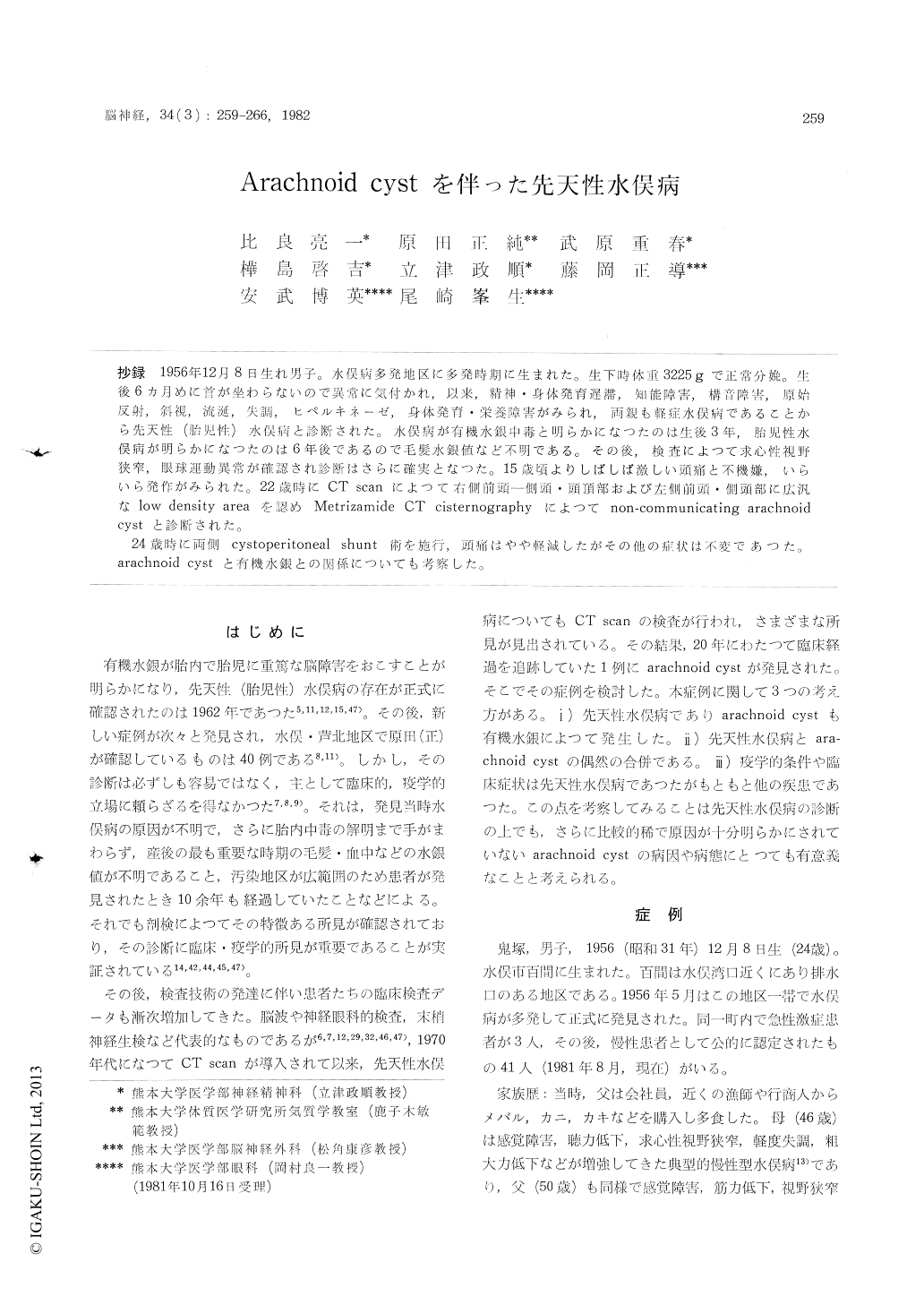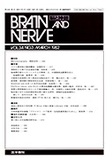Japanese
English
- 有料閲覧
- Abstract 文献概要
- 1ページ目 Look Inside
抄録 1956年12月8日生れ男子。水俣病多発地区に多発時期に生まれた。生下時体量3225gで正常分娩。生後6カ月めに首が坐わらないので異常に気付かれ,以来,精神・身体発育遅滞,知能障害,構音障害,原始反射,斜視,流涎,失調,ヒペルキネーゼ,身体発育・栄養障害がみられ,両親も軽症水俣病であることから先天性(胎児性)水俣病と診断された。水俣病が有機水銀中毒と明らかになつたのは生後3年,胎児性水俣病が明らかになつたのは6年後であるので毛髪水銀値など不明である。その後,検査によつて求心性視野狭窄,眼球連動異常が確認され診断はさらに確実となつた。15歳頃よりしばしば激しい頭痛と不機嫌,いらいら発作がみられた。22歳時にCT scanによつて右側前頭一側頭・頭頂部および左側前頭・側頭部に広汎なlow density areaを認めMetrizamide CT cisternographyによつてnon-communicating arachnoidcystと診断された。
24歳時に両側cystoperitoneal shunt術を施行,頭痛はやや軽滅したがその他の症状は不変であつた。arachnoid cystと有機水銀との関係についても考察した。
A male, born on December 8, 1956, during the period when many Minamata diseases broke out in a district. His parents who ate much fish and shell-fish taken in Minamata Bay suffered from the light, incomplete Minamata disease showing sensory disturbance, the constriction of the visual field, muscular weakness, etc.
He weighed 3,225 gr. upon the normal birth given 10 months after pregnancy. His abnormal-ities were noted since his head was not stabilized on the neck even six months after the birth. Because of the delay in the development of the motor function, he became barely able to sit, stand up and begin walking at the ages of 3, 5 and 6 respectively. In 1962 (at the age of 6), his con-genital Minamata disease was diagnosed in view of his clinical symptoms and epidemiological con-ditions. The mercury value in the hair and blood upon the birth is not known because a considerable time had elapsed after the birth when his mercury poisoning was discovered.
However, the clinical symptoms included intel-ligence disturbance, character change, dysarthria, primitive reflexes, strabismus, hypersalivation, ataxia and hyperkinesia, indicating a typical con-genital Minamata disease. Until he became 13 years old (1969) or so, his mental and motor func-tion developed, both gradually. In the same year, he was admitted to a special class for the handi-capped. EEG examination revealed that there was a slow a activity in the basic pattern and that 6 Hz positive spike was found in the sleep EEG. The constriction of the visual field was classified through examination.
When 15 years old in 1971, he complained of severe headache and showed irritability and emo-tional unstability as wall as displeasure. Additional-ly, his neurological symptoms somewhat deterio-rated again. CT scanning examination disclosed that extensive localized low densities existed in the right frontal, temporal and parietal region on one hand as well as the left frontal and temporal region on the other. Further, a diagnosis of his non-communicating arachnoid cyst was made by metri-zamide CT cisternography.
Both-side custoperitoneal shunt was carried out in March, 1981. Nevertheless, neither clinical symptoms nor CT scanning findings sl owed any noticeable change despite some relief from the headache.
The epidemiological conditions and clinical symp-toms were not contradictory to the congenital Minamata disease. Arachnoid cysts in general show no other neurological symptoms than headache and epilepsy. It cannot be said, therefore, that his varied neurological symptoms were caused by arach-noid cysts. At present, its cause is not definite but it is generally considered to come from the congenital malformation during intrauterine period. On the other hand, it has been considered that the organic mercury poisoning during intrauterine period is rather fetopathy than embriopathy, i. e. no congenital malformation is observed in congeni-tal Minamata diseases. However, the latest results of animal experiments and clinical epidemiological studies suggest that organic mercury may induce congenital abnormalities. Therefore, the authors consider the symptoms as rather attributable to the arachnoid cyst as the congenital malformation due to organic mercury poisoning during intra-uterine period than to the accidental complication of Minamata disease and arachnoid cyst.

Copyright © 1982, Igaku-Shoin Ltd. All rights reserved.


